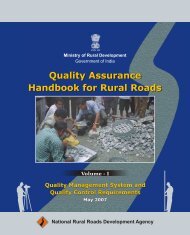Grameen Sampark Final April 0... - pmgsy
Grameen Sampark Final April 0... - pmgsy
Grameen Sampark Final April 0... - pmgsy
Create successful ePaper yourself
Turn your PDF publications into a flip-book with our unique Google optimized e-Paper software.
10<br />
Construction of Sub grade<br />
This is the foundation layer over which the block<br />
pavement is constructed. Like in conventional<br />
pavements, the depth of water table should not be at a<br />
level of 600 mm or higher, below the subgrade level. It<br />
should be compacted in layers of 150 mm thickness.<br />
The prepared subgrade should be graded and surface<br />
dressed to a tolerance of ± 20 mm of the design levels,<br />
and its surface evenness should have a tolerance of<br />
within 15 mm under a 3 m straight edge [7].<br />
Construction of Base and Sub-base Layers<br />
Base course and Sub-base course are constructed in<br />
accordance with the standard procedures contained in<br />
relevant IRC specifications like IRC:37-2001; IRC:50-<br />
1973; IRC:51-1993; IRC:63-1976; IRC:19-1997. When<br />
cement treated bound base is proposed it may be<br />
constructed using rolled dry lean concrete as IRC:SP-<br />
49-1998. The quality control methods, as specified in<br />
IRC: SP-11-1988 shall apply. Constructing these layers<br />
to the proper level and grade is very much essential to<br />
maintain the top surface level and surface regularity of<br />
the block pavement surface.<br />
<strong>Grameen</strong> <strong>Sampark</strong><br />
Edge Restraint Blocks and Kerbs<br />
Concrete blocks subjected to traffic tend to move<br />
sideways and forward due to braking and maneuvering<br />
of vehicles. The tendency to move sideways has to be<br />
counteracted at edges by provisions of special edge<br />
blocks and kerbs. The edge blocks should be designed<br />
and anchored to the base such that the rotation or<br />
displacement of blocks is resisted [7]. These blocks are<br />
to be made of high strength concrete for withstanding<br />
the traffic wheel-loads without getting damaged. These<br />
members should be manufactured or constructed in-situ<br />
in order to have at least a 28-days characteristic<br />
compressive strength of 30 MPa or flexural strength of<br />
3.8 MPa. As far as possible, the edge blocks should have<br />
vertical face towards the inside blocks. Where the space<br />
does not easily permit the use of plate vibrators,<br />
dhurmut or manual compactor using small size plate<br />
rammer may be used. The road kerbs provided on edges<br />
of roads also serve the purpose of edge blocks. In case<br />
the kerbs are not provided, it has to be replaced by the<br />
edge strips. In case of heavy traffic, 150 mm x 150 mm<br />
(height x width) plain cement concrete (M-25) may also<br />
be provided over dry lean concrete to give further<br />
confinement to the blocks. In-between the edgerestraint<br />
blocks, cement mortar (1: 6, cement: coarse<br />
sand) may be used in place of sand for sealing of blocks.<br />
Placing and Screeding of Bedding Sand<br />
The thickness of sand bedding after compaction should<br />
be in the range of 20-40 mm, whereas, in the loose form,<br />
it should be 25 to 50 mm. It is preferable to restrict the<br />
compacted thickness to about 20-25 mm to reduce the<br />
risk of any localized over-compaction, which would<br />
affect the final block surface level. Bedding sand should<br />
not be used to fill-up local depressions on the surface of<br />
base or sub-base layers. The depressions, if any, should<br />
be repaired with same base or sub-base material in<br />
advance before placing the sand. The sand of specified<br />
gradation, should be uniformly in loose condition, and<br />
should have uniform moisture content. Optimum<br />
moisture content is when sand is neither too wet nor too<br />
dry and has moisture of about 6 to 8 percent.

















